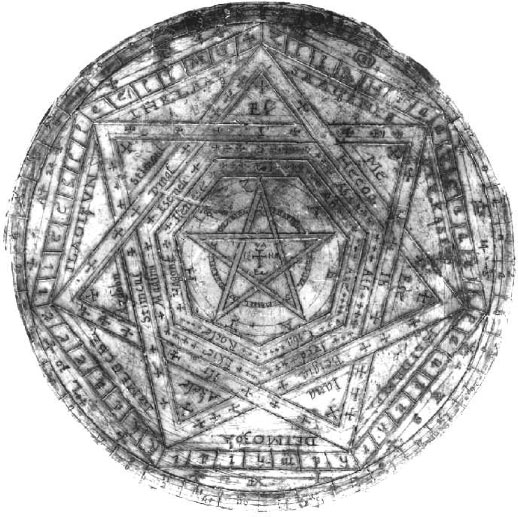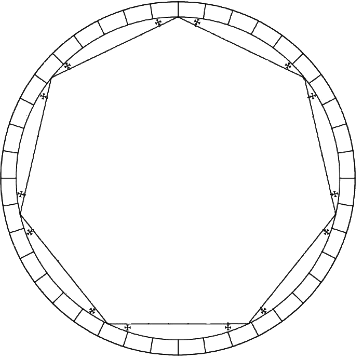Preface
The Sigillum Dei Aemeth is one of the most curious and complex symbols in the literature of the occult sciences. Its mysterious character first takes its present form in Liber Secundus Mysteriorum,1 the second book of John Dee and Edward Kelly’s somewhat infamous Spirit Actions.
Our purpose here is almost purely mechanical. It is to describe in detail how the symbolic forms of the Sigillum may be attributed, with proofs and demonstrations of those attributions. In doing so we hope to provide some insight into how this symbolic structure may be used as a framework and paradigm of magickal practice. By proofs and demonstrations we appeal to the standard and traditional methods of deduction, geometry2 and qabalistic attributions.3
It can be said that the so-called Enochian system can be divided into three larger interrelated parts that correspond to the traditional divisions of ceremonial magick. These are elementary, planetary and astrological. Although the system is complex and these divisions sometimes fuzzy, in a general sense the Sigillum falls within the larger planetary subset, as the Watchtowers fall within the elemental subset and the Aires or Aethyrs within the zodiacal.4
It is recommended that those who wish to study this material in depth become familiar with the primary source material, that is Dee’s Mysteriorum Liber Quinque, particularly Liber Secundus, which contains the reception and principle explication of the figure. Other texts by Dee that bear on the issues raise in the Sigillum include his Propeaedumata Aphoristica5, Monas Hieroglyphica6, De Heptarchia Mystica7, the Introduction to Billingsley’s Euclid8 and the collection of Spirit Actions contained in Casaubon’s A True & Faithful Relation9; Lon Milo DuQuette’s Enochian Vision Magick10 and Donald Tyson’s Enochian Magic for Beginners11 are admirable overviews of the Dee material from a magickal perspective.
Some familiarity with the occult sciences of the period is also useful and Cornelius Agrippa’s Three Books of Occult Philosophy12, the pseudo Agrippan Fourth Book13, the Heptameron of Petri di Abano14, and the Arbatel15 are recommended as sources from which it is known that Dee worked, also useful are the Sworn Book of Honorius16, the Armadel17, the various Keys of Solomon and the Magus of Francis Barrett.18
A full grounding in the science and occult practices of the period would be too much to expect for most readers but the serious student will do well to become familiar with the works of Frances A. Yates, particularly Giordano Bruno and the Hermetic Tradition, The Art of Memory, and The Rosicrucian Enlightenment.19
Our sources will be noted in detail in the course of this series and a more fully annotated bibliography provided at its conclusion.
I. The Principle Divisions
The Sigillum itself is divided into 4 principle parts: 3 on the obverse or front and 1 on the revers, base or back. Each of these sections, though containing multiple constructs, is derived from a unique set of values: either a combination of letters and numbers or letters alone.
These are deemed the:
Obverse
I. Circumference
II. Septagon
III. Matrix
IV. Cross
These can be fairly correlated to the 4 worlds of the Hebrew Qabalists.
I. | Circumference | Atziluth |
II. | Septagon | Briah |
III. | Matrix | Yetzirah |
IV. | Cross | Assiah |
This places the deific forces in Atziluth, the Archangels in Briah, the Angels in Yetzirah and the AGLA of the Cross as ruling North and Earth to Assiah. As Can be seen these reflect the traditional attribution of the letters of the Tetragrammaton to the four worlds and the reflection of the elements into the division of the higher worlds. In this way the outermost circle represents the farthest celestial realms, the enclosing septagon the dimension of time, the inscribed heptagram and hetpagons the descending planetary spheres and the base the elemental world of mundane existence.
A theory of planetary magick:
Structurally stable catastrophe as the mother of form.
“We shall see that classical Euclidian geometry can be considered as magic: at the price of minimal distortion of appearances (a point without size, a line without width) the purely formal language of geometry describes adequately the reality of space. We might say, in this sense, that geometry is successful magic. I should like to state the converse: is not all magic, to the extent that it is successful, geometry?”
René Thom. Structural Stability and Morphogenesis. p. 11 n 4
The Geometric parts of the Sigillum.
Here we use basic Classical (such as Ptolemy) and Grimoric forms as set forth in Dee’s Propaedeumata Aphoristica. Simply stated Astronomical or positional, Astrological or symbolic and Chronological via traditional governments of hours. Form is achieved by using set theory and isolating each aspect until all three overlap into a triangulation. In simplest terms this may be achieved, for instance, when a planet is above the horizon, on its day and in its hour and when it is in a sign which it rules. For these purposes the circumference is attributed the Celestial sphere and thus the positions of the planets on the background of the stars, the Archangels of the Septagon to the government of Planetary hours and this to the rulership of temporal conditions, and to the angelic exemplars of the planets are attributed the basic symbolism of astrological rulership. More anon, but let us first look at each section in turn.
In Liber Secundus these three major division are referred to as Thrones, Trumpets and Angels.
“Mark this Mystery Seven comprehendeth the Secrets of Heven and erth:
Seven knitteth mans sowle and body togither.
(3, in sowle, and 4 in body)In 7, thow shalt finde the Unitie
In 7, thow shalt finde the Trinitie
In 7, thow shalt finde the Sonne, and the proportions of the Holy Ghoste.
O God, O God, O God, Thy Name (O God,) be praysed ever,
from thy 7 Thrones, from they 7 Trumpets and from thy 7 Angels.
In 7, God wrowght all things.
In 7, and by 7 must you work all things
O Seven tymes Seven, Veritie, Vertue and Majestie”
Michael - Liber Secundus Mysteriorum: 21 March 1582
On the obverse there are 3 sets of letters that form the various collections of names:
- The Circumference: The 40 Chambers about the edge
- The Septagon: The 49 Chambers inscribed within the Circumference
- The Matrix: The 7 Names of 7 parts each that are set within the isosceles triangle that result from the inscription of the Heptagram within the Septagon.
“Who is the image of the invisible God, the firstborn of every creature: For by him were all things created that are in heaven, and that are in earth, visible and invisible, whether they be thrones, or dominions, or principalities, or powers: all things were created by him, and for him:”
Colossians 1:15–16 (KJV)
Thrones: From and in the 40 Chambers of the Circumference are three sets of spiritual creatures.
- 40 angels are individually associated with the Chambers themselves, their letters and numbers.
- 7 (plus 2 or 3 hidden) names are drawn by the arithmetical algorithm from the Circumference.
- The 7 Alphanumeric Seals located within the semicircles that result from the inscription of the Septagon within the Circumference.
Trumpets: From the Septagon of the 49 Chambers inscribed within the Circumference 2 sets:
- 7 Baskets containing 7 avian creatures, some real, others mythical.
- 7 (=1) Archangels, the 7 Angels that stand before the Holy Throne etc. (+ Uriel after a fashion).
Angels:
- 7 Pillars divided each into 7 Parts and containing alphabetical, alphanumeric and numeric data.
- A Family of Light containing 28 members (maybe less)
Heptagram:
i. Daughters in the Angles
ii. Sons in the linesPrimary Heptagon:
iii. Daughters of the Daughters wihtin the sidesSecondary Heptagon:
iv. Sons of the Sons within the sides - Pentagram: 7 Planetary Angels: around, about and within Calvary Cross
Notes:
1. The original MS. of this text containe Sloane MS. 3188: “Enochian Manuscripts Online.” The Magickal Review. http://www.themagickalreview.org/enochian/mss. There is a slightly more intact copy, by Elias Ashmole, which is contained in Sloane MS. 3677, and some of the missing text can be recovered from Dee’s own extracts in the Heptarchia Mystica. There are three major full editions of this text, in Christopher Whitby's John Dee's Actions With Spirits: 22 December 1581 to 23 May 1583, 2 vols. (New York: Garland, 1991). Joseph Peterson’s John Dee's Five Books of Mystery (York Beach, ME: Weiser, 2003) and Clay Holden’s online ed. Mysteriorum Liber Secundus. trans. Raymond and Susan Drewry. (John Dee Publication Project. 1999) http://hermetic.com/jdpp/. The latest editions of the later are the best of these.
2. The serious student would do well to acquire and work through the Thirteen Books of Euclid. The Heath edt.: Euclid. The Thirteen Books of the Elements, 3 vols. trans. Thomas L. Heath. (New York: Dover, 1956) also provides an admirable introduction with important information about John Dee.
3. Aryeh Kaplan ed. & trans. Sefer Yetzirah: The Book of Creation. (York Beach, ME: Weiser, 1997) is the best introduction to the classica methods of qabalistic logic.
4. For a basic overview of this relationship see David R Jones. “The System of Enochian Magick, Part I: An Introduction to the Structure of Enochian Magick." Lion and Serpent (Portland, OR: Sekhet-Maat Lodge, O.T.O.) http://hermetic.com/jones/the-system-of-enochian-magick/ and http://sekhetmaat.com/wiki/Journal/Read
5. Wayne Shumaker ed. & trans. John Dee on Astronomy: Propaedeumata Aphoristica (1558 & 1568), Latin and English. (Berkeley, CA: Univ. of California, 1978).
6. C. H. Josten, trans. “Monas Hieroglyphica.” Ambix, vol. XII. (Cambridge, UK: Society for the History of Alchemy and Chemistry, 1964) is by far the best presentation of this material but The Hieroglyphic Monad by Dr. John Dee and translated with commentary by J. W. Hamilton Jones (York Beach, ME: Weiser, 1975) and the numerous online editions based on it are serviceable.
7. Sloane MSS. 3191 & 3678, in Geoffrey James Enochian Evocation/Magick of Dr. John Dee. (Gillette, NJ: Heptangle, 1984 & St. Paul, MN: Llewellyn, 1994.) and Robert Turner’s Heptarchia Mystica. (Edinburgh: Magnus Opus Hermetic Sourceworks, 1983) republished with translations and useful addenda as The Heptarchia Mystica of John Dee (Wellingborough, UK: Aquarian, 1986).
...





